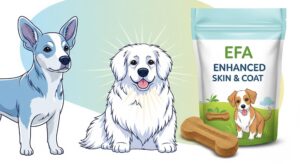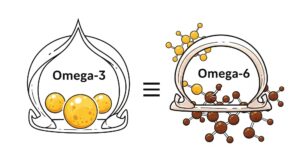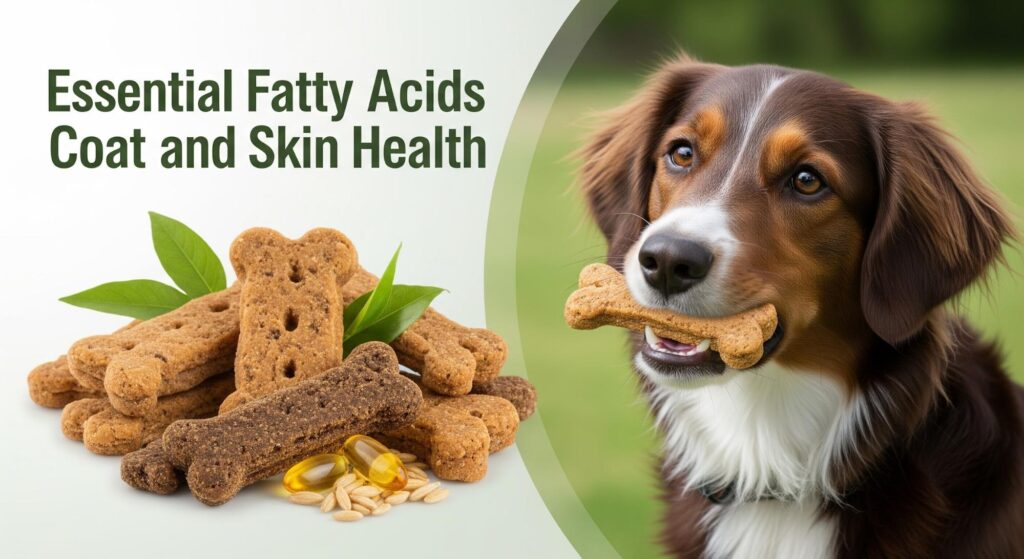A dog’s skin and coat are not just for looks; they are vital indicators of overall health. The shine of your dog’s fur and the smoothness of their skin are clear signs that their body is receiving the necessary nutrients. Essential fatty acids (EFAs), particularly omega-3 and omega-6, play a crucial role in maintaining your dog’s skin and coat in top condition. Since dogs are unable to produce these EFAs on their own, they must obtain them from their food or treats.
EFAs help in several ways:
-
They keep the skin moisturized and prevent dryness or flakiness.
-
They support the growth of a soft, shiny coat and reduce shedding.
What Are Essential Fatty Acids, and Why Do Dogs Need Them?
Essential fatty acids are healthy fats that your dog’s body can’t make on its own. They must come from food. The most important EFAs for dogs include:
-
Omega-3 fatty acids: Found in fish oils like salmon and sardines. They reduce inflammation and keep skin hydrated.
-
Omega-6 fatty acids: Found in plant oils such as sunflower or safflower oil. They help promote skin cell growth and coat shine.
Dogs lacking these nutrients may show signs like flaky skin, excessive shedding, itching, or dull, brittle fur. That’s why adding EFA-rich treats is more than just a reward; it’s a wellness move.
Benefits of EFA-Enhanced Dog Treats for Skin and Coat:

Dog treats enriched with essential fatty acids act as a daily beauty regimen for your furry friend. Here’s what they do:
-
Reduce dry, flaky skin: Omega-3s work as a natural moisturizer from the inside.
-
Control itchiness and allergies: EFAs soothe inflamed skin caused by allergens or dryness.
-
Boost coat shine and softness: Omega-6 helps the fur retain moisture and improve texture.
-
Strengthen skin barrier: This helps keep infections and hot spots away.
The real magic? When given consistently, EFAs can improve your dog’s appearance within weeks. Plus, treats make it easy; your dog won’t even know it’s healthy!
Right Balance of Omega-3 and Omega-6:

Not all fatty acids are created equal. Your dog’s body requires a balanced ratio of Omega-3 to Omega-6. An excess of Omega-6, which is common in commercial pet foods, can trigger inflammation instead of reducing it.
Here’s a table to show how these EFAs work and where they come from:
When choosing dog treats, look for those that clearly list the source and ratio of these oils. Brands like Pawpfect are known for using quality ingredients and maintaining proper balance.
How to Choose the Right Treats with EFAs:
Picking the right EFA dog treat can feel overwhelming with so many options. Here are a few simple tips:
-
Check the ingredients: Look for named fish oils (like “salmon oil”) or plant oils (like “flaxseed oil”).
-
Avoid fillers: Treats packed with artificial flavours or grains may cancel out the benefits of EFAs.
-
See visible results: Most dogs show a glossier coat and reduced itching within 4 to 6 weeks of daily use.
And don’t just go by fancy packaging. Choose treats that are vet-recommended or discussed in professional spaces like vet conferences 2025. Professionals, including vet tech experts, are now encouraging pet owners to turn to treats with real nutritional value, not just flavour.
Are EFA Treats Safe for All Dogs?
Yes, in general, EFA dog treats are safe for all breeds and ages, but moderation is key. Like all good things, too much fat, even healthy ones, can lead to:
-
Upset stomach
-
Loose stool
-
Unintended weight gain
If your dog is overweight or on a special diet, talk to your vet before adding any new treats. For specific concerns, you can explore resources and products through Pawpfect, where you’ll find treats formulated to be both tasty and safe.
What Experts Are Saying About Essential Fatty Acids:

EFAs are gaining more attention in professional circles than ever before. At upcoming vet conferences, there will be sessions focused entirely on nutrition for skin and coat health.
These conferences are crucial because they update professionals on the latest science, helping them guide pet parents toward better choices.
Conclusion:
Essential fatty acids might be small nutrients, but they wield a transformative power in your dog’s life. From soothing itchy skin to enhancing coat shine, the right EFA-rich treats offer a beacon of hope for improving your pet’s health naturally.
As science advances and more findings are shared through vet communities, it’s clear that treats can be tools, not just snacks.
For a trusted place to start your journey, browse the healthy and wholesome dog treats at Pawpfect, where quality meets care and if your dog is overweight.
1. What specific ratios of omega-3 to omega-6 should be included in dog treats for optimal health?
A healthy ratio of omega-6 to omega-3 in dog treats typically ranges from 5:1 to 10:1. This balance helps control inflammation and supports skin and coat health. Too much omega-6 without enough omega-3 can actually worsen inflammation, so it’s important to check product labels or consult your vet for guidance.
2. Are there any potential side effects of introducing EFA treats to a dog’s diet?
While EFAs are generally safe, some dogs may experience mild side effects such as loose stools, gas, or an upset stomach, especially if introduced too quickly or in large amounts. Start with the recommended dose and monitor your dog. If you notice any digestive issues, reduce the serving size and consult your vet if symptoms persist.
3. How can pet owners effectively monitor the improvements in their dog’s skin and coat health?
As a pet owner, you play a crucial role in monitoring your dog’s health. By observing physical signs over a few weeks, such as a shinier coat, less scratching, reduced dandruff, and healthier skin texture, you can track the positive impact of EFA-rich treats. Taking clear before-and-after photos can help you spot subtle improvements, and regular brushing and gentle skin checks are also great ways to monitor progress.



